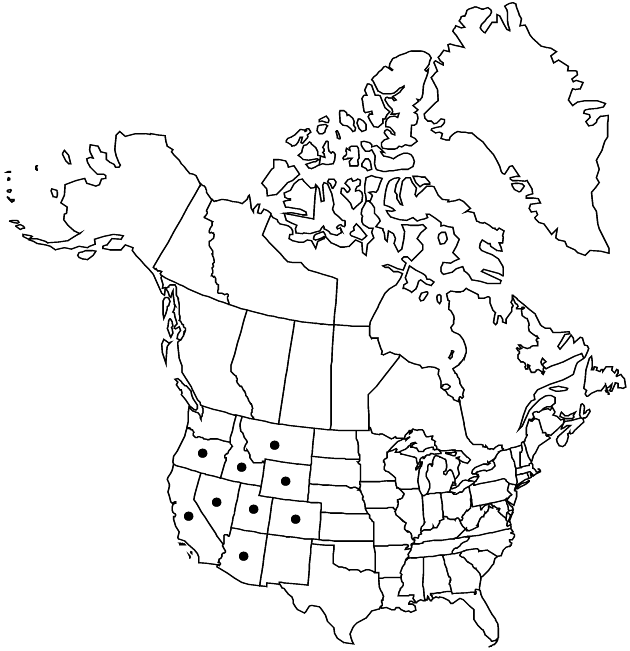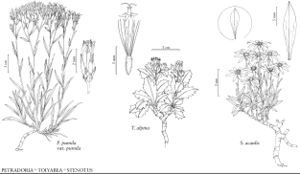Stenotus acaulis
Trans. Amer. Philos. Soc., n. s. 7: 334. 1840.
Plants 3–21 cm (cespitose or matted; taproots stout). Stems proximally clothed with marcescent leaves, glabrous or scabrous, eglandular, viscid or stipitate-glandular. Leaves basal and cauline; petiolate; blades 1-nerved or 3-nerved (conspicuously raised abaxially), usually linear to broadly oblanceolate, sometimes spatulate, 5–85 × 0.8–11 mm, rigid, margins usually roughly scabrous (cilia spreading-ascending, stiff), apices acute, faces glabrous or scabrous, eglandular, viscid, or stipitate-glandular. Heads 1–2 (–4). Peduncles 10–75 mm, glabrous or densely scabrous, usually viscid or stipitate-glandular, sometimes eglandular. Involucres broadly campanulate to hemispheric, 9–16 (–20) × 6–11 (–14) mm. Phyllaries 10–26 in 2 (–3) series, 1-nerved or 3-nerved, ± unequal, outer lanceolate to oblong or occasionally oblanceolate, 3.5–9 × 1.5–3.5 mm, inner oblong, 6–12 × 1–4 mm, proximally indurate, ± keeled, distally chartaceous, green portions longer than broad, margins scarious, sometimes broadly so, entire or fimbriate, apices usually acute, rarely obtuse to rounded, sometimes cuspidate, abaxial faces usually glabrous, viscid, sometimes stipitate-glandular or eglandular. Ray-florets 5–13; laminae elliptic to oblong, 5.5–11.5 (–16.5) × 2–6 mm. Disc-florets 17–40; corollas funnelform to vase-shaped, 5–9.5 mm, tubes usually glabrous, rarely sparsely hairy, lobes 0.6–1.3 mm, 1/8–1/5 length of corollas; anthers 1.7–3.5 mm; style-branch appendages subulate to lanceolate, 0.9–2.3 × 0.5 mm, stigmatic lines 0.6–1.5 (–2.5) mm, lengths 1/2 appendages. Cypselae 2–4.5 (–6) mm, lengths 1/2–3/4 disc corollas, faces sericeous or glabrous; pappus bristles 28–65, 4–7.5 (–10) mm, about equaling disc corollas. 2n = 18, 36.
Phenology: Flowering late spring; fruiting early summer.
Habitat: Sagebrush, open pine forests, pinyon-juniper woodlands, and alpine meadows, on limestone, sandstone, granitic, or occasionally basaltic soils
Elevation: 1200–3600 m
Distribution

Ariz., Calif., Colo., Idaho, Mont., Nev., Oreg., Utah, Wyo.
Discussion
In areas of sympatry, Stenotus acaulis usually is easily distinguishable from S. armerioides by its broadly oblanceolate leaves with markedly scabrous margins, and weakly unequal phyllaries with longer than broad green portions and acute apices. These characters sometimes fail where the ranges of the two species overlap, especially in Colorado and eastern Wyoming, and (as noted below) near the limit of the range of S. armerioides in southwestern Utah. Such plants frequently must be assigned to one species or the other based on phyllary characters alone.
As many as eight species have been described within what is recognized here as a single variable taxon comprising intergrading populations. Most treatments published subsequently to that of H. M. Hall (1928) have recognized two infraspecific taxa within S. acaulis, subsp. acaulis with scabrous, ± basally disposed leaves, and subsp. glabratus with glabrous, ± cauline leaves. Those two phases intergrade extensively and I have been unable to satisfy myself with their circumscription. Moreover, their recognition appears to obscure relationships among populations that appear to be unified by a suite of characters but would be assigned to different infraspecific taxa were pubescence the primary discriminating feature. Careful work may yet shed light on ecogeographically distinct populations worthy of taxonomic recognition. Two of those merit comment here.
The first, members of which have been described as Stenotus acaulis var. kennedyi Jepson and as a distinct species by other authors, comprises populations found in northeastern California, northwestern Nevada, and adjacent parts of Oregon and Idaho. Individual plants produce extensive aboveground woody growth and possess large, campanulate heads, with relatively few, broadly oblong, 3-nerved phyllaries with obtuse or ± rounded apices, and thinly sericeous or glabrous cypselae. Each of those characters varies independently of the others, however, and plants grade into forms typical of the species in central Idaho and Nevada.
The second is an exceptionally narrow-leaved form, historically segregated as Stenotus falcatus Rydberg, found in southwestern Utah and northeastern Nevada. Vegetatively, these plants are similar to narrow-leaved specimens of S. armerioides var. armerioides, approaching that taxon in habit, especially their possession of stout caudex branches and rather long-petiolate leaves with entire margins and viscid faces. Individuals often have at least 2, and usually 3–4 small, campanulate heads per stem, with strongly cuspidate phyllaries. At their extreme, populations of this form could easily be taken for a distinct species; however, plants grade into the typical phase in central Utah and larger collections of populations demonstrate a range of variation from one phase to the other. The taxon described recently from Juab County, Utah, as Haplopappus acaulis var. atwoodii may belong to this morphotype, but I have not seen the type material.
Selected References
None.
Lower Taxa
"fine" is not a number.
